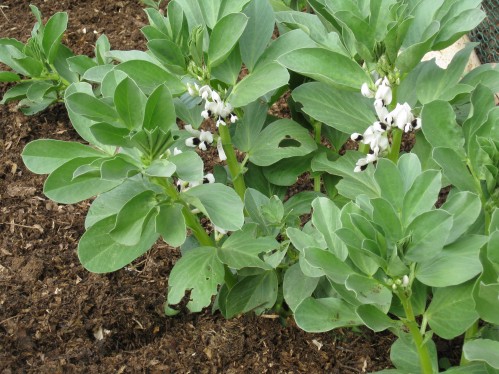Do You Grow Fava Beans?
 I generally plant fava beans in my potager every year. I think it is because they remind me of Europe. Fava beans were a staple in northern Europe before the introduction and popularity of the potato. When I'm in Europe, I see fava beans for sale at outdoor markets, and mentioned often on restaurant menus. While fava beans have been cultivated in Europe for centuries, fava beans are relatively new to the American farm, market, and garden.
I generally plant fava beans in my potager every year. I think it is because they remind me of Europe. Fava beans were a staple in northern Europe before the introduction and popularity of the potato. When I'm in Europe, I see fava beans for sale at outdoor markets, and mentioned often on restaurant menus. While fava beans have been cultivated in Europe for centuries, fava beans are relatively new to the American farm, market, and garden.
I absolutely adore their catchy black and white flowers which remind me of black-eyed peas. Oh yes, and I love their slightly nutty buttery taste, too. Fava beans are also known by the names; Broad beans, Windsor beans, English beans, and a few others. (Please note, in some cases, a few people can be allergic to, or have an enzyme deficiency to fava beans. I have never experienced this or heard of this personally before, but have seen it in my reading).
In mild climates such as Southern California, I sow my fava beans in the fall, and patiently wait 150-180 days later, for harvest in spring. Fava beans are a legume, and require a long, cool growing season. Fava beans are also considered a beneficial cover crop, because they are high in nitrogen, and return nitrogen back, enriching the soil where they are grown.
I plant my fava bean seeds in a large full sun plot in my potager, where their height won't affect my other growing vegetables. Seeds need to be planted about 2" deep, and 6" apart. Allow for about 24" between your rows. Mature fava bean plants, do not require staking or support, and can reach 4' to 5' high yielding apple green pods, 6" to 8" inches long, with 5 to 7 beans in each pod.
The best reason for growing fresh fava beans is their wonderful taste and versatility. You can utilize young tender fava bean pods whole, or shelled when mature. Fava beans can be used in light spring pastas, hearty soups, pureed as a dip, sauteed as a vegetable, or used as a substitute for lima beans. It seems like every year, I see yet another creative way to use fava beans in spring recipes.
If you are not familiar with fava beans, I whole-heartedly recommend growing them sometime. Fava bean seeds are easy to find through your favorite seed catalogs. Territorial Seed and Botanical Interests both carry fava beans. In the garden, fava beans are quite striking in appearance, easy to grow and cultivate, add nitrogen back to your soil, and reap a tasty spring legume.
Please share if you are familiar with, and grow fava beans in your garden? Please comment on your favorite way to enjoy fava beans.
Thank you for supporting VintageGardenGal's sponsors!